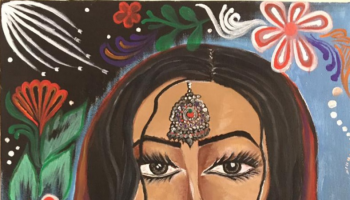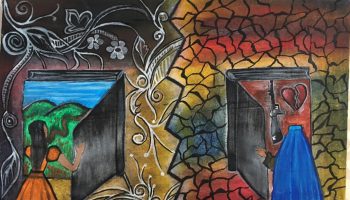Words by Anonymous
Art by Kathy Lee
In April, Melbourne-based artist Zhou Xiaoping launched a body of ground-breaking research on the history of Aboriginal-Chinese people in Australia. Held at the Chinese Museum, I was lucky to attend the packed event celebrating two of the world’s oldest cultures.
At one point in the evening, Xiaoping touched on the inspiration for his work. Following his travels near the Kimberley Desert in 1989, he recounted meeting four Aboriginal Australians. Seated around the campfire, all four had distinct Chinese facial features but knew little about their Chinese heritage. One Aboriginal man, named Ah Lee, even unsuccessfully tried to converse with Xiaoping in Chinese, much to the amusement of his friends. He later explained, “We all Aboriginal. But everyone tells me, I am Chinaman. Now I see you…em, yeah…I am, we look the same, right?”
The intertwined history shared by Indigenous Australians and the Chinese reaches beyond ancestral links. Our peoples also share similar – though distinct – experiences of discrimination.
When British colonists first arrived in Australia, they claimed the country belonged to no-one to justify taking land already occupied by First Nations peoples. Assimilation policies were later introduced. The colonial lawmakers may have intended to ‘protect’ and ‘advance’ Indigenous communities by necessitating the adoption of European culture, but many laws were oppressive and discriminatory. Such policies facilitated the removal of Indigenous children from their parents. Families were torn apart, and millennia of culture and connections to land were disrupted.
While this was occurring, Australia was still experiencing the aftermath of late-nineteenth century gold rush migration. As it became harder to find gold, thousands of Chinese families who had been working the gold fields began to establish restaurants, laundries, furniture shops and fisheries. White Australia did not always take kindly to Chinese migrants. Alfred Deakin, the second Prime Minister of Australia, assisted in the implementation of the White Australia Policy. The “alien races,” he said, were a threat because of “their inexhaustible energy, their power of applying themselves to new tasks, [and] their endurance.”
The White Australia Policy was finally phased out in the 1970s, and laws protecting culturally diverse Australians from racial discrimination were introduced. We have come a long way. Australia is now a land of opportunity for migrants around the world, with an overwhelming majority of the country supporting multiculturalism. Like so many Australians of Chinese descent, I have been fortunate to benefit from the prosperity our great nation offers.
By comparison, most Indigenous Australians have not been as lucky. Indigenous Australians remain over-represented in the criminal justice system, and continue to experience worse outcomes in education, employment, and health. Despite our good intentions, we are failing to close the gap. The legacies of past discrimination can be seen in present disadvantage.
The stories shared by the Chinese and Indigenous Australians are very different, but there are grounds for mutual empathy: we have both experienced discrimination in this country. A key difference is that while my parents chose to migrate here in search of opportunity, Indigenous Australians have lived in Australia for centuries as the traditional custodians of the lands on which we have since prospered. They had nowhere else to go when settlers and migrants arrived on their shores, just as they had little say in the laws made by the colonists.
The discriminatory policies of the past may have been prevented, or at least improved, if Indigenous people had been fairly heard. Today, we can do better. That is why Indigenous Australians are asking for a constitutionally guaranteed First Nations Voice.
Five years ago, an unprecedented national consensus of Indigenous Australians released the Uluru Statement from the Heart. They called for an Indigenous advisory body, guaranteed by the Constitution, to provide non-binding recommendations on laws and policies relating to Indigenous Australians.
The Australian community is responding positively to the proposal. In May, our country’s peak religious institutions released an unprecedented joint resolution calling for bipartisan action to hold a referendum on a First Nations voice.. Christians, Jews, Muslims, Sikhs, Hindus, and Buddhists alike have made their support for a First Nations voice known. This demonstrates communities around the country looking beyond their differences and coming together for the greater good
Indigenous peoples need the support of every Australian, whatever race, creed, or colour, to show our political leaders this is something we care about. As a country that recognises our vibrant multiculturalism as one of our greatest strengths, modern Australia must not shy away from the Uluru Statement’s modest request.
I am calling on Chinese Australians to step up in solidarity and empathy, to vocally support a First Nations constitutional voice. After all, our histories are entwined. We share links of blood in Australian history. We also share some experiences of past discrimination. I urge the Chinese community to support the Uluru Statement from the Heart.
Gavin Choong is a fourth-year law student at Monash University, and an intern at the Radical Centre Reform Lab.


